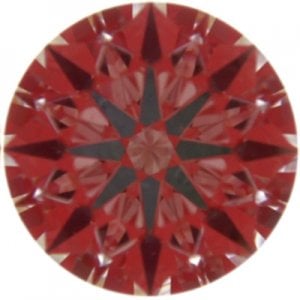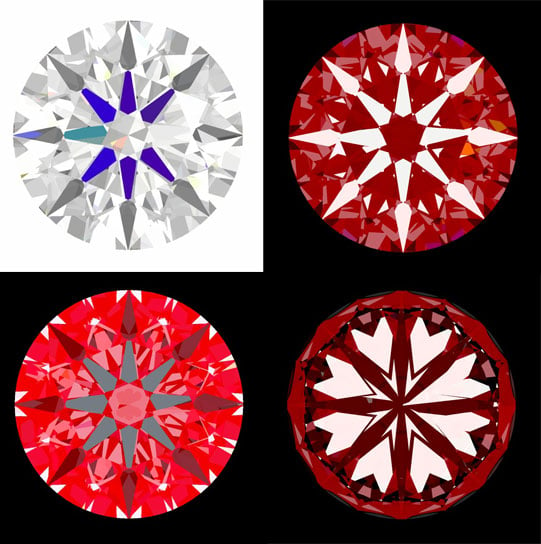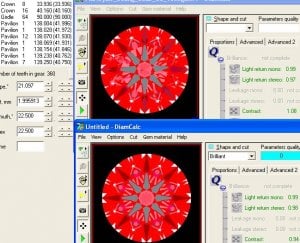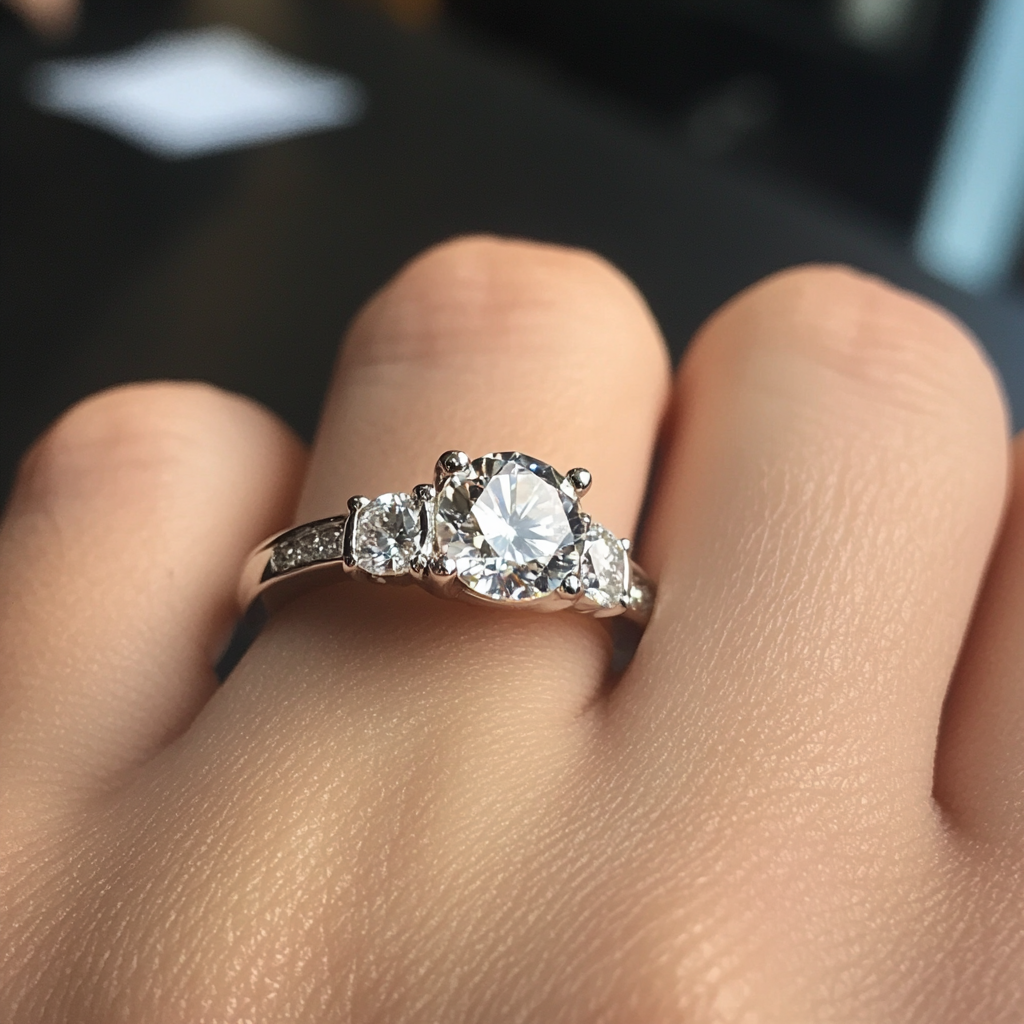JohnQuixote
Ideal_Rock
- Joined
- Sep 9, 2004
- Messages
- 5,212
You want to be Bill Gates?Date: 8/26/2005 4:53:08 PM
Author: Wink
In my next life I want to be born with a math computer chip in my brain and enough money to buy all the new toys!
You want to be Bill Gates?Date: 8/26/2005 4:53:08 PM
Author: Wink
In my next life I want to be born with a math computer chip in my brain and enough money to buy all the new toys!

Here are crown views for a diamond with 2 yawed mains (the ones with yellow on them).Date: 8/7/2005 8:37:10 PM
Author: JohnQuixote
Lightscope is unsuccessful for the same simple reasons other Gilbertson-based reflectors are.
FIRST: As mentioned, you can’t see it in the crown view, as the arrows camouflage what’s going on. The mains are dark due to obscuration and you can’t detect anything in them.
SECOND: What you think you’re seeing under the table could be any number of things. The simplest cause could be leveling of the diamond. It could be angle variance. It could be the diamond out of round or simple azimuth shift. To confuse the issue, the stars and the table itself reflect in the center of the image while the lower girdle divisions have multiple reflections. It is a jambalaya of different elements that are subject to tertiary reflections and distortions.
As for your reflector colors, slight hue changes within those double reflections could be due to tilt, the diamond out of round, patterning variation, angle variance or even a fingerprint on the light source. They may have nothing to do with azimuth shift and if they do there is no way to tell if they are some sort of ancillary yaw without first looking for primary yaw in the pavilion mains which is very simple to do with the H&A viewer.
So even assuming you have a 100% perfectly level diamond, these things still have multiple causes and multiple reflections. The thing we do know is that it’s not yaw.


Edge detection machines we are aware of do not take enough measurements to "see" facet yaw. Remember these devices measure only certain points and assume straight lines. When polishing a real life diamond there are deviations possible in places that the current machines do not measure: Their edge detection merely assumes a certain line is there thus the inability to see indented naturals and yaw.
These additional slope measurements would be necessary in order to evaluate the amount of yaw caused by the azimuth shift – and by the way things were adjusted by the cutter. Remember, he did what he could to straighten things out which has disguised but not omitted the yaw.
Now if possible this would be easier on large facets but much more difficult on smaller surfaces.


LOL keep askin questions its the only way to learn.Date: 8/27/2005 5:29:37 PM
Author: Shay37
Storm, never mind. I see that John answered me on the previous page. See I told ya I was a PITA.
Shay
http://www.gemology.ru/cut/english/symmetry/10.htmDate: 8/27/2005 5:45:03 PM
Author: strmrdr
One thing im starting to see is that yawing just one facet if the cutter tries to fix it throws off a lot more than just that facet.
And can throw the whole diamond off.
Would it be better from a performance standpoint to take a hit in meet point symmetry and not try and fix it or is hiding it the proper action?
Date: 8/27/2005 7:41:20 AM
Author: strmrdr
hmmmm,
Im still digesting all this but one thing that is standing out what is the affect of yawed crown facets,LGF and other facets it would seem that it would not only be the pavilian mains that could be hard to cut and get yawed if they gave problems?
Its obvious that the hearts are going to be messed up.
Iv noticed in the past that while its harder to see that you can usualy tell face up if the hearts are messed up in h&a images and IS images but even more so in the lightscope.
Post the double reflection wire frame picture from DC please side by side with the same specs with no yaw. It is the one that matches the patterns showed on IS and lightscope shots.
If yaw can be seen there face up it can be seen in the other face up images to one extent or another.

It’s all driven by $$$. Ex or Id symmetry = more $$$. There is no reward for absence of yaw – and plenty in straightening it out to try and fool the machines.Would it be better from a performance standpoint to take a hit in meet point symmetry and not try and fix it or is hiding it the proper action?
Date: 8/28/2005 12:49:02 AM
Author: strmrdr
Ah sir John but the Jedi master could not the broken arrow mend.
The patterns between the arrows their own story do they tell.
Do listen you?


i am not worthyDate: 8/27/2005 3:29:14 AM
Author: JohnQuixote
- I think you are very worthy of the gem file.PM me and I'll get it to you.

doh!!Date: 8/27/2005 3:29:14 AM
Author: JohnQuixote
I looked at your adjustments. If you want to go much further here is a tip: Remember which is the most important view of all. It will reveal much. Do you still want to work on it some?


after spending waaaaaay too much time clicking away and breaking every cutting rule out there while trying to 'fix' leonid's diamond, i totally understand what you are saying. it's not about what one can do with a click of a mouse on a virtual model....what matters is what you can actually do with a very expensive piece of rough, in hand at the wheel. what i was doing with diamcalc could not be done in real life (good thing....that stone was toast on more than one occasion!) it was fun playing with it though, i learned a lot about the way angles work together and how each facet can be tuned ever so fine (and not so fine!) to perfection. i have the upmost respect for brian and what he can do in real life. i will continue to play with diamcalc to try and learn what i can about the relationship of facets and their effects on a diamond, but i know that no matter how much time i spend on it clicking away with my mouse, without practical experience, i am no closer to being a cutter.Date: 8/28/2005 1:48:16 AM
Author: JohnQuixote
Date: 8/28/2005 12:49:02 AM
Author: strmrdr
Ah sir John but the Jedi master could not the broken arrow mend.
The patterns between the arrows their own story do they tell.
Do listen you?
Hehe.
Ah, listen I do... But you do not hear, youngling.
You’re looking at this as a guy who clicks buttons in software. What Brian did was to transcend that and treat the virtual as real. I think that’s a fundamental problem causing some communication dysfunction in this thread.
Sure, any of us could click the software by 2 degrees and put everything back to 0, but you can’t do that in the real world. In cutting when mistakes are made you have to take away more diamond to repair it. In order to straighten out a real diamond like that the whole pavilion would have to be re-done in 8 cut, so Brian left the main azimuth shift in the original position that Leonid placed it in.
Then he only made fixes that could be 'real.' That was the whole point, young jedi-to-be.
He treated the virtual model as if it were actual and broke no rules with wire-frame clicks. He took a diamond that would be considered poorly produced and showed you how to SAVE that diamond without losing a ton of weight.
When you think about it, it really is compelling, and the main point here. Those who don’t cut maybe didn’t get that. No problem, but it’s definitely worth a ‘kewl’ or two.

Strm it is a fair question but not a fiscal priority. It makes economic sense to acquire id or ex meet sym, This is graded while optical is not. It is why I am working hard to bring these things to light.Date: 8/29/2005 1:09:46 AM
Author: strmrdr
Next question:
could Jedi master the arrow save for a good sym. rating settle?
or is it gone too far?
